Pensions are the foremost way that people invest for their retirement, but those who have maxed out their £40,000 annual allowance may turn to Lifetime ISAs as a backup.
This gives investors room for an additional £4,000 to invest every year, with the government matching 25% of the amount contributed. When investors are nearing retirement, they can then begin withdrawing money from the age of 60 tax-free, or the money can be used earlier if used for the purchase of a first home.
For those needing the money in the near future for a house, investing in risky assets is nor recommended. Here, Trustnet asks fund experts for suggestions if using the Lifetime ISA for retirement.
Andy Merricks, fund manager at 8AM Global, recommended that investors consider the Heptagon Future Trends fund, which invests in companies with the potential to benefit from trends that could lead markets over the long term.
He said: “I’ve long been a believer in investing in what the world wants and needs, particularly when looking ahead. The Heptagon Future Trends Fund sets out to do exactly this and, importantly, does it pretty well.”
It is up 151.6% since the fund launched in 2016, beating its peers in the IA Global sector by 42.4 percentage points.
Total return of fund vs benchmark and sector since launch
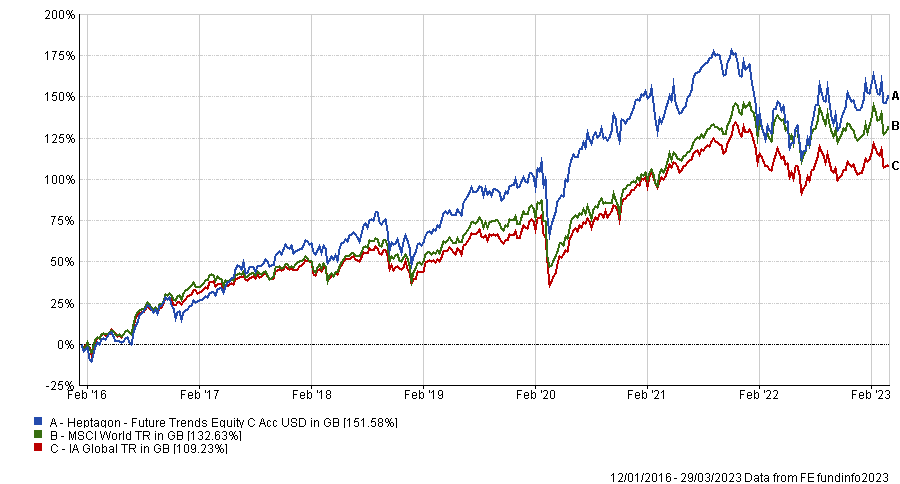
Source: FE Analytics
Despite being a top-quartile performer over the past five years, Merricks said that the fund had “fallen under the radar” of most investors.
However, he noted that the $138m fund’s 1.28% ongoing charges figure (OCF) – that makes it one of the most expensive in the sector – could put some investors off.
It may be on the pricey side, but that it has beaten both actively managed global portfolios and passive funds tracking the MSCI World benchmark since launch justifies a higher fee, according to Merricks.
He said: “There is a case to be made for active managers who are skilled at their job justifying the fees that they charge.
“There will of course be those that say that the outperformance of the fund is merely a long-term blip, which is bound to fail at some point, but personally I’m happy to recommend an investment that seemingly rewards investors and management alike as it continues to meet its objectives.”
Its focus on long-term trends has led some large overweights in high-growth sectors such as information technology, which accounts for 34.4% of the portfolio (compared to 21.3% in benchmark index).
Likewise, it has no exposure to lower-growth areas such as financials and communications services, which make up 14.6% and 6.6% of the MSCI World.
Like many funds leaning towards growth, it suffered a 9.7% drop in returns last year, but it still did better than its IA Global peers.
Total return of benchmark and sector in 2022
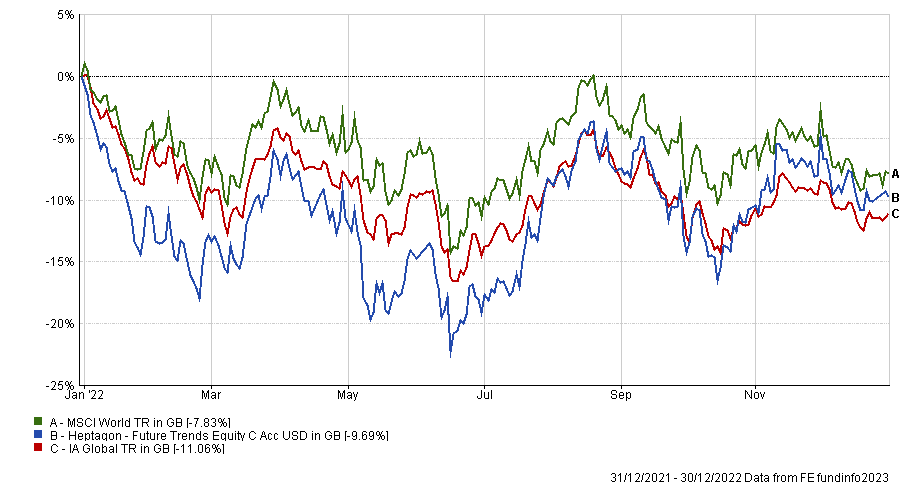
Source: FE Analytics
Passive funds tracking the index did outperform, as they did in most sectors last year, but its shallower loss highlights its defensiveness compared to its active peers, according to Merricks.
He said: “The fund should have been badly hit in 2022 as the sectors that it tends to follow fell massively out of favour, but although it lost value overall, it held up remarkably well and is testament to the idea of investing in future trends. As trends change over time, so, I anticipate, will the makeup of the portfolio.”
Another fund that could suit an investor at the start or end of their retirement saving is Schroder Asian Income, recommended by Darius McDermott, managing director of FundCalibre.
He said that Asia is “by far the most dynamic of the world’s major regions” both over the short and long term, making a compelling investment case for any investor regardless of their time horizon.
Asia may not be the first region that springs to mind when investors think of income, but the MSCI AC Pacific ex Japan index’s average dividend yield of 3.3% is attractive against other indices such as the MSCI ACWI, which yields 2.3%.
McDermott pointed out that dividends in Asia are not far off the 3.5% available from the FTSE All Share index, with the UK generally being income investors’ favoured market.
Schroder Asian Income pays more than these indices with its 4.7% dividend yield, making it one of the highest payers in the IA Asia Pacific Excluding Japan sector.
Richard Sennitt has been managing the fund since 2001 and his expertise in the field is one of the main appeals for McDermott.
He said: “Richard Sennitt’s experience, combined with the strength and depth of this team, make this fund stand out in my view.
“He has a real focus on identifying companies that can grow shareholder value in the long term, the investment process is well thought out and has been implemented with diligence and skill.”
Returns are up 102% over the past decade, during which time it beat its peer group by 30.9 percentage points.
Total return of fund vs sector and benchmark over the past decade
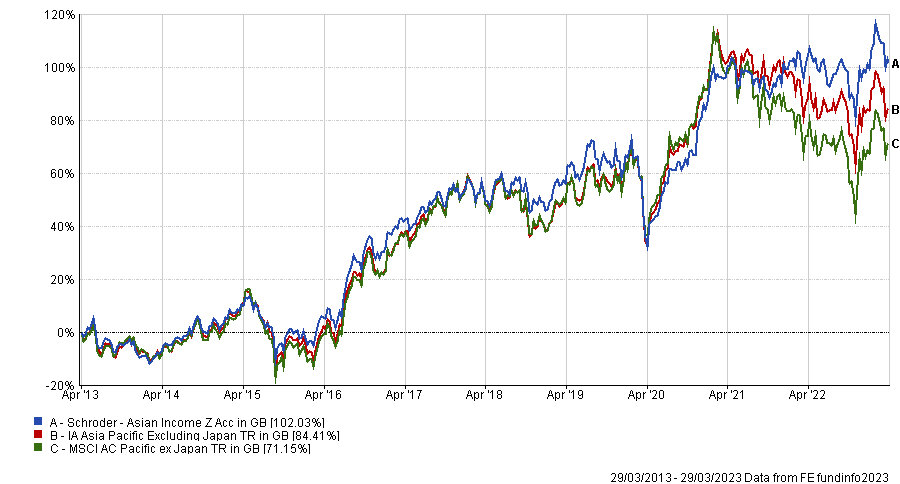
Source: FE Analytics
Its largest overweights are financials, information technology and real estate, which account for 67.4% of the fund’s sector allocations.
These sectors account for 46.9% of the benchmark index, but analysts at FE fundinfo said the fund offered good diversification despite these concentrated allocations.
“We like it that the fund does not purely buy companies in only the highest yielding sectors – capital appreciation is equally important,” they said.
They added that Schroder Asia Income has a defensive quality that protects it during market downturns, such as last year, when its 0.2% return beat the average 6.9% loss made by its peers.
Total return of fund vs sector and benchmark in 2022
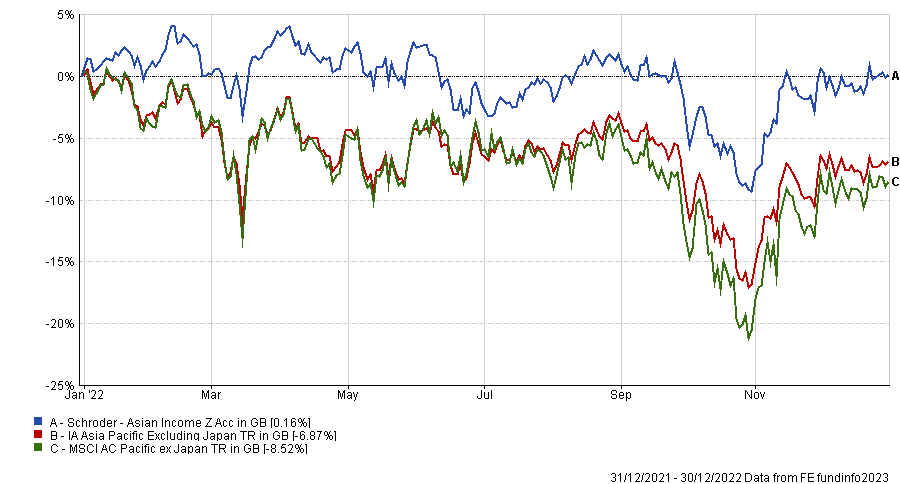
Source: FE Analytics
However, this could close it off to big gains on the upside, so investors buying in now to benefit from an upturn of growth in Asia might not find a sizable rebound here.
FE fundinfo analyst said: “The fund is biased towards quality companies, so it should hold up better than the market in down markets but may not capture the upside fully in rising markets.
“It struggles to keep up in strongly rising markets, particularly when large non-dividend-paying Chinese internet companies drove the market, such as in 2017, 2019 and 2020.”
Another option is Schroder Asian Income Maximiser, which yields 7.1% and is run by the same manager.
Alternatively, investors looking to add to their Lifetime ISA might want to go down the passive route with Legal & General Future World ESG Developed Index, suggested by Emma Wall, head of investment analysis and research at Hargreaves Lansdown.
It is up 47.2% since it launched in 2019 and has beaten the rest of the IA Global sector by 13.2 percentage during its lifespan.
Wall also chose the tracker as her top pick for a Junior ISA account last week, but said it might not be the best option for investors with a short time horizon.
Total return of fund vs sector since launch
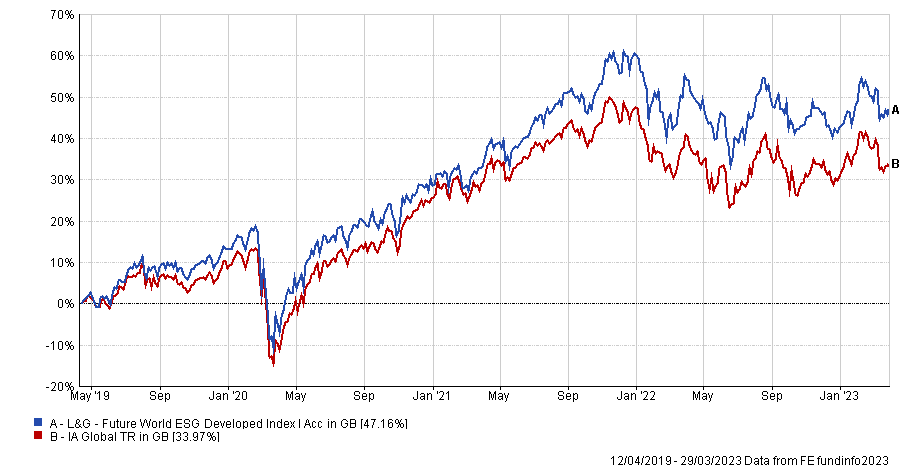
Source: FE Analytics
Those looking to retire and access their Lifetime ISA allowance within the next five years are better off not investing it in markets and keeping it in cash, according to Wall.
She said: “The different time horizons should mean a different attitude to risk – in fact if you’re planning on buying a house within five years, cash may be a better option for your LISA allowance. Assuming a longer-term outlook, equity investments fit the bill.”
Investors with a longer wait before their retirement years could get exposure to a set of global equities from this index with the added benefit of environmental, social and governance (ESG) screening.
Wall added: “An index tracker fund is one of the simplest ways to invest, and this one could be a good addition to a broader investment portfolio aiming to deliver long-term growth in a responsible way.”





